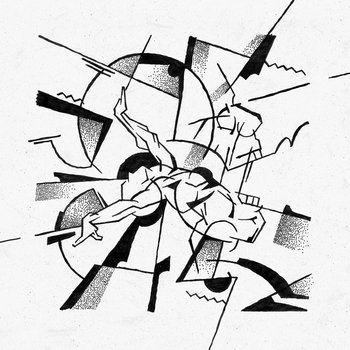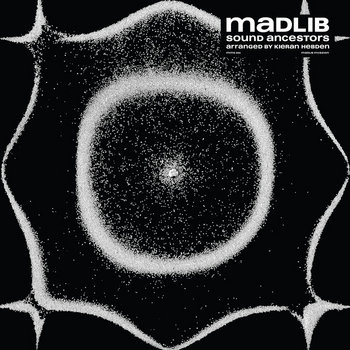- Eve McGivern
- Sound Bytes
 The name Terry Gross brings to mind the NPR host. This Terry Gross is comprised of music industry veterans guitarist Phil Manley (Trans Am, the Fucking Champs, Life Coach), bassist Donny Newenhouse (Film School, Hot Fog, Buffalo Tooth), and drummer Phil Becker (Pins of Light, ex-Triclops! and Lower Forty-Eight). Where the radio host provides content with an impossibly calm demeanor, the musical trio present three heavy and kinetic tracks that serve up pulsating motorik rhythms, heavy sludge, driving bass, and intense guitars served up at mesmerizing cosmic volumes — all the while, pulling us listeners in with a constant array of melodic hooks.
The name Terry Gross brings to mind the NPR host. This Terry Gross is comprised of music industry veterans guitarist Phil Manley (Trans Am, the Fucking Champs, Life Coach), bassist Donny Newenhouse (Film School, Hot Fog, Buffalo Tooth), and drummer Phil Becker (Pins of Light, ex-Triclops! and Lower Forty-Eight). Where the radio host provides content with an impossibly calm demeanor, the musical trio present three heavy and kinetic tracks that serve up pulsating motorik rhythms, heavy sludge, driving bass, and intense guitars served up at mesmerizing cosmic volumes — all the while, pulling us listeners in with a constant array of melodic hooks.
Soft Opening it is most definitely not, as the appropriately named "Space Voyage Mission" comes blasting out of the gate with pulsating, interstellar fuzzadelic intensity, diving into an onslaught of guitars before floating away into motorik beauty of shimmering guitars. Nearly 20 minutes of booming rhythms and guitar-driven melodic madness does not feel too long for this massive slab of heavy beauty. Manley's work with Trans Am can be sensed, bringing a particular lightness and groove to the kraut-driven tracks, yet perfectly capable of metallic sludge. "Worm Gear" kicks off with persistent kraut beats and cascading, guitar distortion that finds all three musicians merging into a slathering of Sabbath-worthy heaviness.
Much of the album is instrumental, letting the instruments work their magic, but it is not devoid of vocals. "Specificity (Or What Have You" finds the trio providing a united chorus over an incredibly catchy rhythm and a memorable bass line that ends on an explosion of fuzzed-out rock and roll. This is a perfect candidate for radio play, but as amazing as that track is, it doesn't begin to serve as the pinnacle of the album, the other tracks masterworks of their own.
Tight play between guitar, bass, and drums reveals obvious chemistry between the three, honed over time with practice and experimentation. Just how much practice was required to achieve this near-seamless integration between genres remains unknown; there's always a risk of such projects becoming one-offs. I'll go on a limb and suggest there's more to look forward to from this talented trio, each a component of the whole.
- Eve McGivern
- Albums and Singles
 The name Terry Gross brings to mind the NPR host. This Terry Gross is comprised of music industry veterans guitarist Phil Manley (Trans Am, the Fucking Champs, Life Coach), bassist Donny Newenhouse (Film School, Hot Fog, Buffalo Tooth), and drummer Phil Becker (Pins of Light, ex-Triclops! and Lower Forty-Eight). Where the radio host provides content with an impossibly calm demeanor, the musical trio present three heavy and kinetic tracks that serve up pulsating motorik rhythms, heavy sludge, driving bass, and intense guitars served up at mesmerizing cosmic volumes — all the while, pulling us listeners in with a constant array of melodic hooks.
The name Terry Gross brings to mind the NPR host. This Terry Gross is comprised of music industry veterans guitarist Phil Manley (Trans Am, the Fucking Champs, Life Coach), bassist Donny Newenhouse (Film School, Hot Fog, Buffalo Tooth), and drummer Phil Becker (Pins of Light, ex-Triclops! and Lower Forty-Eight). Where the radio host provides content with an impossibly calm demeanor, the musical trio present three heavy and kinetic tracks that serve up pulsating motorik rhythms, heavy sludge, driving bass, and intense guitars served up at mesmerizing cosmic volumes — all the while, pulling us listeners in with a constant array of melodic hooks.
Soft Opening it is most definitely not, as the appropriately named “Space Voyage Mission” comes blasting out of the gate with pulsating, interstellar fuzzadelic intensity, diving into an onslaught of guitars before floating away into motorik beauty of shimmering guitars. Nearly 20 minutes of booming rhythms and guitar-driven melodic madness does not feel too long for this massive slab of heavy beauty. Manley’s work with Trans Am can be sensed, bringing a particular lightness and groove to the kraut-driven tracks, yet perfectly capable of metallic sludge. “Worm Gear” kicks off with persistent kraut beats and cascading, guitar distortion that finds all three musicians merging into a slathering of Sabbath-worthy heaviness.
Much of the album is instrumental, letting the instruments work their magic, but it is not devoid of vocals. “Specificity (Or What Have You” finds the trio providing a united chorus over an incredibly catchy rhythm and a memorable bass line that ends on an explosion of fuzzed-out rock and roll. This is a perfect candidate for radio play, but as amazing as that track is, it doesn’t begin to serve as the pinnacle of the album, the other tracks masterworks of their own.
Tight play between guitar, bass, and drums reveals obvious chemistry between the three, honed over time with practice and experimentation. Just how much practice was required to achieve this near-seamless integration between genres remains unknown; there’s always a risk of such projects becoming one-offs. I’ll go on a limb and suggest there’s more to look forward to from this talented trio, each a component of the whole.
Read More
- Anthony D'Amico
- Albums and Singles

This latest installment of Geographic North's frequently wonderful Sketches for Winter series is a new album from Oslo's restlessly evolving Carmen Villain and it is a fitfully (and strikingly) brilliant one. While the general aesthetic of Perlita is roughly akin to the more psych-minded side of private press new age, it is inventively mingled with an evocative and enigmatic array of field recordings, submerged beats, and hallucinatory flourishes to achieve something truly vivid, distinctive, and absorbing. In fact, the closing "Agua Azul" completely blindsided me, approximating an unexpectedly sensual, dubwise, and almost tropical-sounding update of Apollo-era Brian Eno.
This album joins the pantheon of releases that I would have described as "pretty good, I guess" before I threw on some headphones and belatedly experienced its full depth and clarity. In my defense, the first two pieces could easily be mistaken for deconstructed Enya on their face, but there are hints of greater emotional depth and mystery in even Perlita's most overtly tranquil pieces. In the opening "Everything Without Shadow," that side quietly manifests in drones that lazily hiss, fray, and bleed as a corroded vocal sample repeats below the surface. In the following "Two Halves Touching," however, the full extent of Villain's vision starts to become apparent, as a lurching "outsider dub" groove emerges from a miasma of deep bass, rhythmically sloshing waves, and a repeating, hallucinatory vocal loop. From that point onward, the album only descends into increasingly poignant and pleasantly phantasmagoric territory. Listening to Perlita feels like entering a blissful and dreamlike floating world where someone else's flickering, non-linear childhood memories are being projected. That experience is further enhanced by the intrusion of enigmatically meaningful outside sounds that drift in and lazily reverberate around until they fade away. Successfully casting and sustaining such a reality-dissolving spell is achievement enough, yet Perlita culminates in a final piece ("Agua Azul") that takes the album to a transcendent new level with a smoky flute melody and a slow, sensual groove…then tops it all off with a rain of slowly falling synth tones that feels like a sky full of slow-motion fireworks. Is that what heaven is like? I sure hope so. While it is currently only January, I am certain "Agua Azul" will absolutely be one of the most gorgeous pieces that anyone releases this year, as envisioning what could surpass it strains the limits of my imagination.
Samples can be found here.
Read More
- Anthony D'Amico
- Albums and Singles

Newly reissued on vinyl on her own Gate imprint, A 480 was Coverdale's formal debut (originally issued on Constellation Tatsu back in 2014). When I first heard it a few years back, I believed it was not nearly as strong as her breakthrough 2017 EP Grafts, but I have since revised and reversed that opinion as A 480 has its own (very different) flashes of brilliance—they just require a bit more focused listening to reveal themselves. This is both a unique album within Coverdale's discography and a unique album in general, approximating a slow-burning strain of loop-driven kosmische-style psychedelia assembled from ingeniously manipulated vocal loops.
Constellation Tatsu/Gate
The album's brief opener amusingly feels like a targeted assault on my personal sensibility, but the cheerily artificial textures and manic repetition of "A 480 are admittedly quite an effective illustration of the album's overarching vision. In essence, A 480 was crafted entirely from vocal pieces that have been "unpersonally sourced, downloaded, then disembodied, disfigured, and displaced over forty times." At various points throughout the album, those vocal loops approximate a human choir, but they far more often sound like a synth album from the '70s that has been chopped up by an Oval-esque mad genius. While both the album's conceptual basis and its source material are certainly intriguing, what truly matters is that the three pieces at the heart of the album all belong in the headphone album hall of fame (sadly still imaginary at this point). That incredible hot streak begins with the half-heavenly/half-futuristic epic "A 479," which sounds like it could have been a lost Tangerine Dream or Popul Vuh soundtrack for Solaris. That feat is then followed by the darkly hallucinatory "A 478" and the alternately playful and poignant otherworldliness of "A 477." Each piece offers its own bit of fiendishly clever compositional sleight of hand, but the thread uniting them all is Coverdale's virtuosic skill at maintaining a consistent sense of forward motion and structure in an endlessly evolving and oft-gorgeous sea of phase-shifting loops. In the passages where everything clicks fully into place, A 480 feels like an almost supernaturally rich and immersive tour de force of subtle rhythmic, harmonic, and melodic mastery. I cannot believe that this was a debut album.
Samples can be found here.
Read More
- Administrator
- Albums and Singles

The follow-up to Johnson’s acclaimed Balsams LP, The Cinder Grove delves further into the compositional possibilities of the pedal steel guitar. This halcyon collection of tracks draws on a wider pallette of sounds, adding strings and piano, to dive deeper into the sound bath of Johnson’s meditative music.
The Cinder Grove is a profound, affecting statement on the nature of loss and irreplaceability as well as a major addition to the canon of Johnson’s work. It's a suite of requiems for lost places. Many of the spaces that once fostered affordable living and creative work now only exist in sonic memory, like the echoes of ghosts. Like much of the California landscape in recent years, some of these spaces having succumbed to fire. Others, to the equally inexorable forces of gentrification. While his 2017 LP Balsams was intended to provide the listener with a space for respite and calm—even healing—The Cinder Grove seeks to remember what has been lost while celebrating the resilience of the human spirit and the natural world.
In making The Cinder Grove, Johnson dug through archival recordings from Oakland DIY performance spaces to digitally extract their reverb and echo qualities. He then applied these effects—as well as the digitally modeled reverberation of a redwood forest—to the tracks on The Cinder Grove, allowing the pieces to bask in the lush virtual spaces, and in the process realized that these sonic re-constructions can only ever be approximations. We try to make spaces what we want them to be, whether in memory or in the material present.
More information can be found here.
Read More
- Administrator
- Albums and Singles

Massive 2-tracker debut EP by hard-hitting Nilotika Drum Ensemble on their ancestral Bugandan percussion. Formed 11 year ago in Kampala, Nilotika have been a staple of Nyege Nyege parties since day one as well as forming the core of the more recent Nihiloxica project. Consisting of seven drummers under the leadership of Jajja Kalanda, Nilotika lure us into a mesmeric sonic kingdom dominated by furious beats against dense and complex polyphonic textures. Played with unrelenting energy and innate power over a repetitive trance-inducing structure both tracks are an urgent exploration of different rhythmic territories through intricate patterns, rapid undulations and haunting build-ups that command you to groove and dance. The first track, "Ejokawulida," is based on rhythms of Iteso traditional music from the eastern part of Uganda, whilst "Kekusimbe" is inspired by a variant of Bugandan traditional music called Bakisiimba.
More information can be found here.
Read More
- Administrator
- Albums and Singles

In Immobile Air is Abul Mogard’s new solo album since 2019's Kimberlin OST, an epochal assembly of widescreen ambient works made during lockdown in Spring 2020.
Master of harmonic empathy Abul Mogard makes an ever welcome return to Ecstatic with a suite of patented pathos for testing times, mostly generated from an old Bechstein upright piano built in 1891.
Inspired as much by the instrument's rich harmonic textures as the Italo Calvino short story that lends the album's track titles, In Immobile Air collects five works written by Mogard during the ill-fated Spring of 2020.
Thematically, the album dwells on Mogard's typical concerns with memory and states of mind, and comes to feel like the musical rendering of a soul preoccupied by their mortality.
As such, it can be read as a suite of instrumental hymns for a world coming to terms with its current condition and state of static unrest, evoking a stillness of air in its glacial movements while reflecting a gnawing sense of something impending. Yet, it's simultaneously and quite profoundly soothing in its widescreen harmonic shifts along the knife-edge between bliss and dread.
The album arrives after a pause in Mogard's prized oeuvre since 2019's And We Are Passing Through Silently with a humbly arresting presence that perfuses all of his best work and keeps his listeners rapt for more.
The handful of pieces speak to both the artist’s rich inner life, and the inner voice of his instrument. Using analog and digital equipment, he transforms the melancholic simplicity of his melodies into a quietly dreamlike space.
The title track lays out this bare aesthetic with wilting, elegiac notes that vaporize into a timbral thizz, before its brooding course takes in the oblique beauty of "Clouds" and tarry drones recalling recent Deathprod moves in "Black Dust." He finally emerges from the murk most poignantly with the clearer keys of "Sand," only to shore up somewhere more contemplative, abstract, in the low key magisterial expanse of "On a Shattered Shell Beach."
The drawings featured in the cover artwork were made by Marco de Sanctis at the same time as the music.
"I think of these drawings as images from his memory, snippets from his past, like Calvino's collection of sand," Mogard offers. "But perhaps they were just drawings."
More information can be found here.
Read More
- Administrator
- Albums and Singles

The last, outstanding release of the London based experimental duo (Tom Relleen and Valentina Magaletti), accomplished just before Tom’s passing in August 2020, is the distillate of two years of new creative enhancement.
Mostly recorded at Tom's "Bunker" – as he called his house in London – during the days off from live performances and challenging collaborations throughout the world, Intimate Immensity collects ten intense tracks that outline a breath-taking epiphanic journey revisiting the multifaceted worlds explored by the band in seven years of non-stop and mostly live activity.
The wonderful blue artwork especially created by the acclaimed artists Icinori is a perfect match with the gist of Tomaga's aesthetics of intimacy that is well expressed by a few lines in the gatefold:
"I just found an interesting book by Gaston Bachelard called The Poetics of Space, with chapters on 'house as universe,' nests, shells, 'intimate immensity,' 'the phenomenology of roundness'... I think it ties in with our feelings about bunkers and the urge to partition the universe to create our own spaces, vs cleansing or colonizing the everyday to make it empty of anyone else's taste. I think Tomaga tracks with their individual micro worlds are a bit like that…" – in this way Relleen introduces us into Tomaga's pulsing universe where space and meaning, articulated by sound, acquire breath and character as an expressive place where you can feel at home.
It is a quite similar aesthetics that could be perceived through Derek Jarman's quotation from Blue (1993) used in the video of "Intimate Immensity" realized by Noriko Okaku together with some of Tom's favourite stones collected from different places throughout his life.
Blue protects white from innocence
Blue drags black with it
Blue is darkness made visible
Blue protects white from innocence
Blue drags black with it
Blue is darkness made visible.
The dialogical richness of musical influences, that has always been a peculiarity of all Tomaga's performances, finds its peak here. The sonic spectrum is really wide, ranging from modern composers such as Laurie Spiegel and Pauline Anna Strom who has recently passed away, to the British refined dance aesthetics of Muslimgauze and Ossia.
The somewhat deceitful approachability of the ten tracks, their crystal clear and elegant surface, is in fact the outcome of the deep process of transformation that has personally and musically involved the duo during the last two years.
Out March 26. 2021 on Hands in the Dark.
Read More
- Administrator
- Albums and Singles

Perc's career defining Bitter Music album from 2017 is re-released for 2021 including all the remixes from the album gathered together for the first time.
First up is the original ten track album including "Look What Your Love Has Done To Me," then come the remixes including reworks from I Hate Models, Dax J, Amelie Lens, Matrixxman, Lucy, Pessimist, Hodge, Perc himself and many more.
More information can be found here.
Read More
- Administrator
- Albums and Singles

Kieren Hebden: "I was listening to some of his new beats and studio sessions when I had the idea that it would be great to hear some of these ideas made into a Madlib solo album ... arranged into tracks that could all flow together in an album designed to be listened to start to finish ... we decided to work on this together with him sending me tracks, loops, ideas and experiments that I would arrange, edit, manipulate and combine. I was sent hundreds of pieces of music over a couple of years."
Out January 29th, 2021. More information can be found here.
Read More
- Anthony D'Amico
- Albums and Singles

Over the last few years, Daisuke Fujita's Meitei project has carved out an intriguing and hard-to-describe niche that brings together several seemingly disparate threads I never expected to see intertwined. The vision at the heart of the project is an attempt to recreate what Fujita calls the Lost Japanese Mood, which makes his work a conceptual kindred spirit to The Caretaker. Meitei can be considerably more eclectic and inventive than that comparison would suggest, however, as there is a subtle sense of playfulness that approximates chopped, screwed, and deconstructed exotica even when the ostensible subject matter is something creepy like Japanese ghost stories.
KITCHEN
Before now, Meitei's work has primarily lingered in fairly "ambient" territory, crafting surreal soundscapes of hazy, crackling loops and enigmatic snatches of dialogue. This latest release, on the other hand, captures Meitei in unexpectedly rhythmic and melodic form and marks a truly revelatory leap forward. It is tempting to describe Kofu as Meitei’s “party album,” as the best moments call to mind the delirious fun of Carl Stone’s recent pop music collages, but there are a lot of haunted, phantasmagoric, and mysterious interludes that would make it one very unsettling party. Both sides of Meitei’s vision have their share of highlights though, as the warbling, hiss-soaked beauty of "Manyo" is every bit as compelling as the propulsive, rapturous left-field beat tape fare of the two-part "Oiran." A handful of pieces feel a bit too incidental to leave a deep impression of their own, but I certainly have no qualms with the eerie, dreamlike spell that they help conjure. If Kofu offered only that, it would still be an appealingly immersive and unusual album, but the most inspired pieces elevate it into something truly sublime and memorable.
Samples can be found here.
Read More

